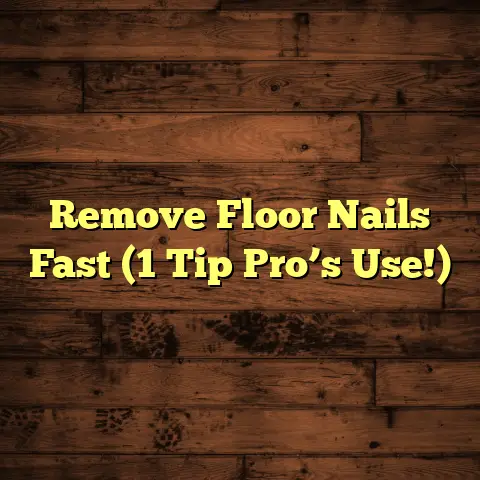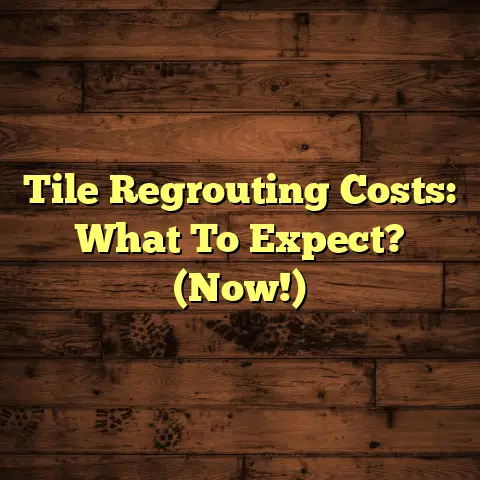Laminate Floor Crackling? (5 Fixes, Act Now!)
Laminate flooring is fantastic, right?
It’s
durable, comes in a zillion styles, and
doesn’t break the bank.
Plus, it’s relatively
easy to install.
But like anything, it’s not
perfect.
That’s where the crackling comes in.
Don’t panic!
It’s usually fixable.
In this
article, I’m going to walk you through the
most common causes of that crackling and,
more importantly, give you 5 actionable fixes.
Let’s get your floor back to its quiet,
beautiful self!
Section 1: Understanding the Causes of Crackling
So, what’s making your floor sound like a
bowl of Rice Krispies?
Here’s the lowdown on
the usual suspects:
Moisture Issues: Think of laminate like a sponge.
Too much moisture from below (like a damp basement) gets absorbed, causing the boards to swell.
Then, when it dries out, they shrink.
This expansion and contraction creates friction, leading to those lovely crackling sounds.
I’ve seen this happen a lot, especially in bathrooms or near leaky appliances.Improper Installation: This is a big one.
Laminate needs room to breathe.
If the installer didn’t leave enough expansion gap around the edges of the room (usually about 1/4 inch), the floor will be too tight.
Also, skimping on the underlayment is a no-no.
Underlayment provides cushioning and helps prevent moisture.
I always tell people, “Don’t cheap out on the underlayment!”Temperature Fluctuations: Just like moisture, temperature changes can wreak havoc.
Extreme heat causes expansion, extreme cold causes contraction.
Think about those summer days when your AC is blasting or those winter nights with the heater cranked up.
These swings put stress on the laminate.Wear and Tear: Let’s face it; floors take a beating.
Over time, heavy foot traffic, furniture, and general wear and tear can loosen the interlocking edges of the laminate planks.
This creates small gaps where the boards rub together, causing noise.Subfloor Problems: Your laminate is only as good as the foundation it’s sitting on.
If your subfloor is uneven, damaged, or not properly prepared, it can cause the laminate to flex and move, leading to crackling.
I’ve seen subfloors with everything from old nail holes to major warping.
To give you a better idea, here’s a table showing common causes and their likelihood:
Now that we know why your floor is crackling, let’s get to the good stuff: the fixes!
Section 2: Fix #1 – Adjusting Humidity Levels
Okay, let’s tackle moisture first.
This is
often the easiest fix, and it can make a
huge difference.
Laminate flooring thrives in a humidity range
of 30% to 50%.
Too high, and the boards
swell; too low, and they shrink.
I recommend
investing in a good hygrometer (you can find
them for around $20) to monitor the humidity
in your home.
Here’s what you can do to adjust the humidity:
Dehumidifiers: If your humidity is consistently above 50%, a dehumidifier is your best friend.
Place it in the room with the crackling floor, or in a central location if the problem is widespread.
I often recommend models with a built-in humidistat so they automatically maintain the correct humidity level.Humidifiers: On the flip side, if your humidity is below 30%, a humidifier will add moisture to the air.
This is especially common in winter when heating systems dry out the air.Ventilation: Proper ventilation is key to preventing moisture buildup.
Make sure bathrooms and kitchens have exhaust fans, and use them!
Open windows occasionally (weather permitting) to circulate fresh air.Year-Round Consistency: The key is to maintain consistent humidity levels year-round.
Don’t let the humidity fluctuate wildly with the seasons.
According to the EPA, maintaining proper
humidity levels can also improve indoor air
quality and reduce the growth of mold and
mildew.
So, you’re not just fixing your
floor; you’re improving your overall health!
EPA Indoor Air Quality.
I’ve seen cases where simply adjusting the
humidity completely eliminated the crackling.
It’s always worth trying this fix first!
Section 3: Fix #2 – Inspecting and Reinstalling the Flooring
If humidity control doesn’t do the trick, it’s
time to get a little more hands-on.
We’re
going to inspect the flooring for signs of
improper installation or damage, and potentially
reinstall some planks.
Here’s how to do it:
Identify Problem Areas: Start by walking across the floor and pinpointing exactly where the crackling is loudest.
Mark these areas with painter’s tape.Inspect the Edges: Check the edges of the room where the laminate meets the wall.
Is there a visible expansion gap?
If not, the flooring is likely too tight.Remove Baseboards (Carefully!): Use a putty knife to gently pry off the baseboards in the problem areas.
This will give you access to the edge of the flooring.Remove Planks (If Necessary): If you suspect improper installation or damage, you may need to remove some planks.
Use a pry bar and tapping block to gently disengage the planks.
Start at the edge of the room and work your way inward.
Be careful not to damage the planks!Inspect Underlayment: Once the planks are removed, inspect the underlayment.
Is it properly installed?
Is it damaged or missing in certain areas?Reinstall Planks (With Proper Spacing): When reinstalling, make sure to leave a 1/4-inch expansion gap around the perimeter of the room.
Use spacers to maintain the gap while you’re working.Replace Damaged Planks: If you find any damaged planks (warped, cracked, or chipped), replace them with new ones.
You may be able to order replacement planks from the manufacturer.
Tools You’ll Need:
- Putty knife
- Pry bar
- Tapping block
- Spacers
- Hammer
- Safety glasses
- Gloves
Safety Precautions:
- Always wear safety glasses to protect your eyes.
- Wear gloves to protect your hands.
- Be careful when using power tools.
- If you’re not comfortable doing this yourself, hire a professional.
I’ve seen situations where simply creating
the proper expansion gap completely eliminated
the crackling.
It’s amazing what a little
breathing room can do!
Section 4: Fix #3 – Temperature Control
We talked about humidity, now let’s talk about
temperature.
Just like moisture, extreme
temperature changes can cause laminate to
expand and contract, leading to crackling.
Here’s how to keep things stable:
Maintain a Stable Temperature: Aim for a consistent temperature in your home, ideally between 65°F and 75°F.
Avoid extreme temperature swings.Acclimate Laminate Before Installation: This is crucial!
Before installing laminate, let it sit in the room for at least 48 hours to acclimate to the temperature and humidity.
This allows the boards to adjust to the environment, minimizing expansion and contraction later on.Heating Systems and Air Conditioning: Be mindful of how your heating and cooling systems affect the flooring.
Avoid placing furniture directly over vents, as this can create hot or cold spots.-
Rugs and Carpets: Use rugs and carpets, especially in high-traffic areas, to insulate the flooring and minimize temperature fluctuations.
According to the U.S.
Department of Energy,
setting your thermostat back 7-10 degrees for
8 hours a day can save you up to 10% on your
energy bill.
U.S.
Department of Energy.
Plus, it’s good for your floor!
I had a client who lived in an old house with
drafty windows.
The temperature near the
windows would fluctuate dramatically, causing
the laminate to crackle.
We added insulation
to the windows and installed thicker curtains,
which helped stabilize the temperature and
eliminate the noise.
Section 5: Fix #4 – Repairing the Subfloor
Remember, your laminate is only as good as the
subfloor underneath.
If the subfloor is uneven
or damaged, it can cause the laminate to flex
and crackle.
Here’s how to assess and repair subfloor issues:
Check for Unevenness: Use a long level (at least 6 feet) to check for unevenness in the subfloor.
Place the level in different directions and look for gaps underneath.Inspect for Damage: Look for signs of damage, such as cracks, holes, or water stains.
These can indicate underlying problems.Leveling the Subfloor: If the subfloor is uneven, you’ll need to level it.
For minor imperfections, you can use self-leveling compound.
For more significant unevenness, you may need to add shims or plywood.Repairing Damaged Sections: If you find damaged sections of the subfloor, you’ll need to repair or replace them.
This may involve patching holes with wood filler, replacing rotted wood, or reinforcing weak areas.
Methods for Leveling a Subfloor:
Self-Leveling Compound: This is a pourable liquid that spreads evenly and hardens to create a smooth surface.
It’s ideal for minor imperfections.Shims: These are thin pieces of wood that can be used to fill gaps and create a level surface.
They’re useful for correcting small dips or humps.-
Plywood: Adding a layer of plywood can help to level a subfloor and provide a more solid foundation for the laminate.
I once worked on a project where the subfloor
was so uneven that you could see waves in the
laminate.
We had to completely remove the
old subfloor and install a new one.
It was
a lot of work, but it made a huge difference
in the stability and sound of the floor.
Section 6: Fix #5 – Regular Maintenance and Care
Okay, you’ve fixed the crackling!
Now, let’s
talk about preventing it from coming back.
Regular maintenance and care are key to
keeping your laminate floor looking and
sounding its best.
Here are some tips:
Routine Cleaning: Sweep or vacuum your laminate floor regularly to remove dust and debris.
This will prevent scratches and wear.Appropriate Cleaning Products: Use cleaning products specifically designed for laminate flooring.
Avoid harsh chemicals or abrasive cleaners, as these can damage the finish.
I recommend a pH-neutral cleaner.Regular Inspections: Inspect your floor regularly for signs of damage or wear.
Catching problems early can prevent them from becoming bigger issues.Furniture Pads and Area Rugs: Use furniture pads under the legs of furniture to prevent scratches and dents.
Place area rugs in high-traffic areas to protect the flooring from wear and tear.
According to the National Wood Flooring
Association (NWFA), proper maintenance can
extend the life of your laminate flooring
by several years.
National Wood Flooring Association.
I always tell my clients, “Treat your floor
like you treat your car.
Regular maintenance
will keep it running smoothly for years to
come.” A little bit of care goes a long way!
Conclusion
So, there you have it! Five fixes for your crackling laminate floor. Let’s recap:
- Adjust Humidity Levels: Aim for 30% to 50%.
- Inspect and Reinstall: Check for proper spacing and damage.
- Control Temperature: Maintain a stable temperature.
- Repair the Subfloor: Ensure a solid foundation.
- Regular Maintenance: Clean and inspect regularly.
Don’t let that crackling drive you crazy!
Take
action now before the problem worsens.
By
addressing the underlying causes and following
these tips, you can restore your laminate
flooring to its optimal condition and enjoy
years of quiet, beautiful floors.
Remember, you’ve got this!
Take control of
your flooring issues and enjoy the low-maintenance
benefits of your laminate floors.
Now go get
’em!





